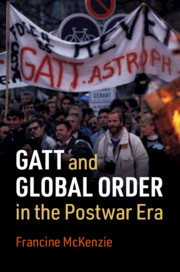Refine search
Actions for selected content:
26946 results in Economic history
Maps
-
- Book:
- Economic Thought in Modern China
- Published online:
- 16 April 2020
- Print publication:
- 07 May 2020, pp viii-viii
-
- Chapter
- Export citation
Dedication
-
- Book:
- Economic Thought in Modern China
- Published online:
- 16 April 2020
- Print publication:
- 07 May 2020, pp v-vi
-
- Chapter
- Export citation
10 - The Growing Polarization of Rural Society during the Second Republic
- from Part V - Rural Conflicts and the Polarization of Village Society
-
- Book:
- Why Democracy Failed
- Published online:
- 17 April 2020
- Print publication:
- 07 May 2020, pp 226-246
-
- Chapter
- Export citation
Part III - Explaining the Weakness of the Family Farm
-
- Book:
- Why Democracy Failed
- Published online:
- 17 April 2020
- Print publication:
- 07 May 2020, pp 103-152
-
- Chapter
- Export citation
Notes on the Regional Division of Spain
-
- Book:
- Why Democracy Failed
- Published online:
- 17 April 2020
- Print publication:
- 07 May 2020, pp xvi-xvii
-
- Chapter
- Export citation
3 - Scarcity Revisited: Population Growth, Frugality, and Self-Strengthening (1800–1911)
-
- Book:
- Economic Thought in Modern China
- Published online:
- 16 April 2020
- Print publication:
- 07 May 2020, pp 109-157
-
- Chapter
- Export citation
1 - The Modernization of European Societies
- from Part I - The European Experience: Economic and Political Development, 1870–1939
-
- Book:
- Why Democracy Failed
- Published online:
- 17 April 2020
- Print publication:
- 07 May 2020, pp 17-34
-
- Chapter
- Export citation
2 - European Agriculture in an Age of Economic Instability
- from Part I - The European Experience: Economic and Political Development, 1870–1939
-
- Book:
- Why Democracy Failed
- Published online:
- 17 April 2020
- Print publication:
- 07 May 2020, pp 35-56
-
- Chapter
- Export citation
Introduction
-
- Book:
- Why Democracy Failed
- Published online:
- 17 April 2020
- Print publication:
- 07 May 2020, pp 1-12
-
- Chapter
- Export citation
Conclusion
-
- Book:
- Economic Thought in Modern China
- Published online:
- 16 April 2020
- Print publication:
- 07 May 2020, pp 197-203
-
- Chapter
- Export citation
Maps
-
- Book:
- Why Democracy Failed
- Published online:
- 17 April 2020
- Print publication:
- 07 May 2020, pp x-x
-
- Chapter
- Export citation
3 - The Limits to Spanish Modernization, 1850–1936
- from Part II - Spanish Agriculture, Economic Development, and Democracy
-
- Book:
- Why Democracy Failed
- Published online:
- 17 April 2020
- Print publication:
- 07 May 2020, pp 59-77
-
- Chapter
- Export citation

GATT and Global Order in the Postwar Era
-
- Published online:
- 02 May 2020
- Print publication:
- 09 April 2020
Graphs and Tables
-
- Book:
- Promoting Global Monetary and Financial Stability
- Published online:
- 10 April 2020
- Print publication:
- 30 April 2020, pp viii-viii
-
- Chapter
- Export citation
Introduction
-
- Book:
- A Silver River in a Silver World
- Published online:
- 18 April 2020
- Print publication:
- 30 April 2020, pp 1-10
-
- Chapter
- Export citation
Annex 2 - BIS-Based Committees – Membership, Chairs and Secretaries, 1962–2020
-
- Book:
- Promoting Global Monetary and Financial Stability
- Published online:
- 10 April 2020
- Print publication:
- 30 April 2020, pp 221-229
-
- Chapter
- Export citation
1 - The Silver World
-
- Book:
- A Silver River in a Silver World
- Published online:
- 18 April 2020
- Print publication:
- 30 April 2020, pp 11-40
-
- Chapter
- Export citation
Contributors
-
- Book:
- Promoting Global Monetary and Financial Stability
- Published online:
- 10 April 2020
- Print publication:
- 30 April 2020, pp ix-xii
-
- Chapter
- Export citation
Annex 3 - BIS Balance Sheet, 1980–2019
-
- Book:
- Promoting Global Monetary and Financial Stability
- Published online:
- 10 April 2020
- Print publication:
- 30 April 2020, pp 230-233
-
- Chapter
- Export citation
Bibliography
-
- Book:
- Promoting Global Monetary and Financial Stability
- Published online:
- 10 April 2020
- Print publication:
- 30 April 2020, pp 241-252
-
- Chapter
- Export citation
